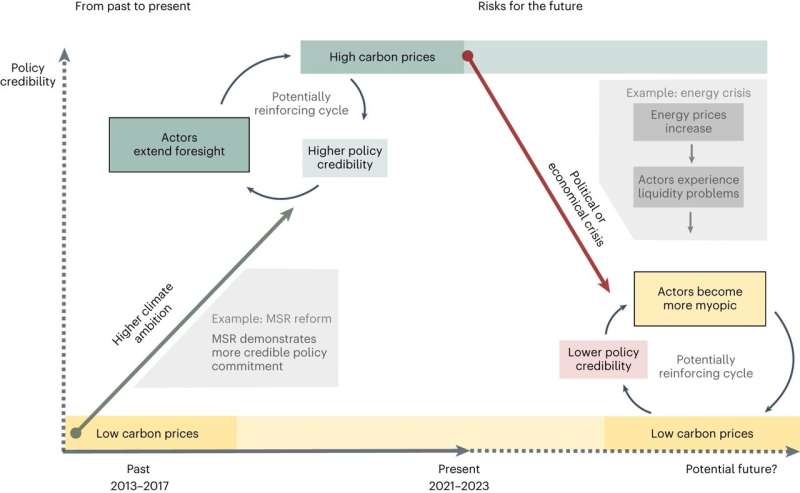This article has been reviewed according to Science X's editorial process and policies. Editors have highlighted the following attributes while ensuring the content's credibility:
fact-checked
peer-reviewed publication
trusted source
proofread
Study finds political commitment in long-term climate policy key for effective EU emissions trading system

High policy credibility is crucial for carbon prices in the EU emissions trading system (EU ETS) to be high enough to efficiently incentivize emission reductions in the long term, a new study finds.
A team of scientists from the Potsdam Institute for Climate Impact Research (PIK) shows that two consecutive ETS reforms elevated CO₂ prices from below 10 Euro per ton of CO₂ in 2017 to about 80 Euro per ton of CO₂ in 2022, not only by tightening the cap, but also by firming up political commitment to it. This effectively made firms act with more foresight, emitting less in the short term to store certificates for future use.
"The price on emitting carbon that is harmful to the climate has risen sharply in the past; basically, it roughly increased tenfold over the last five years and two policy reforms. Our analysis implies that besides directly changing the ETS (emissions trading system) rules, the reforms also increased the long-term credibility of the EU ETS and thereby made firms more farsighted, aligning their market behavior with long-term climate targets," explains Joanna Sitarz, PIK scientist and first author of the study published in Nature Energy.
"In turn, anything that deteriorates the long-term credibility of the EU's climate targets could cause ETS carbon prices to collapse again in the short term and lead to insufficient climate protection investments."
The EU ETS puts a cap and thereby a price on greenhouse gas emissions from power plants, large industrial plants and aviation, covering roughly 40% f the EU's total greenhouse gas emissions. The cap decreases every year and is expected to reach zero around 2040.
The ETS also allows saving certificates: If firms anticipate very high abatement costs in the future, they can reduce emissions today and store the unused emission certificates for future use. This connects current prices to future scarcities, and should lead to dynamic cost-effectiveness: emissions are reduced when it is cheapest.
EU ETS reforms not only strengthened emission cap, but also long-term credibility of climate targets
To analyze the impact of foresight on carbon prices in the EU ETS over the last decade, the researchers modeled carbon prices emerging from the emission caps under different model settings. One setting assumed that firms were farsighted and considered future scarcity of certificates; the second setting assumed that firms focused on the short-term. The analyzed time period covered two large ETS reforms: the Market Stability Reserve MSR in 2018 and the "Fit for 55" proposal in 2021.
The researchers first established that before the 2018 reform, observed prices aligned reasonably well with simulation results for short-sighted firms. "Firms likely doubted the long-term credibility of climate policies and acted mostly with regard to the short-term emission cap," explains Robert Pietzcker, author of the study.
The researchers then found that the price change over the EU ETS reform in 2018 cannot be explained solely by the change of the emission cap itself, but that firms must also have become more farsighted, considering the much stricter emission caps in the distant future.
"After the reform, observed prices increased strongly. When we tested the new rules in our model, the change of caps alone produced only a small price increase in our model when assuming short-sighted firms. Assuming a change to farsighted firms, however, allowed us to reproduce the observed price increase in our model," says Pietzcker.
The authors argue that the political capital invested into the 2018 EU ETS reform strengthened the long-term credibility of the ETS and climate targets to such an extent that firms aligned their market behavior with the expected long-term scarcity of emission certificates.
"The tighter ETS caps in the 'Fit for 55' package increased observed prices to around 80 Euro per ton of CO2 in 2022 and 2023, in line with model results for farsighted firms," states Pietzcker.
The findings have important policy implications, explains Michael Pahle, author of the study, "Policymakers should consider that a drop in prices may not only signal that emission reductions have become cheaper, but could also be an indicator that firms find the long-term cap less credible.
"Notably, the recent drop in carbon prices could be due to the latter. This calls for a revamp of existing mechanisms to stabilize the market, gearing them towards bolstering the price specifically to counteract credibility slumps."
More information: Joanna Sitarz et al, EU carbon prices signal high policy credibility and farsighted actors, Nature Energy (2024). DOI: 10.1038/s41560-024-01505-x
Journal information: Nature Energy
Provided by Potsdam Institute for Climate Impact Research



















